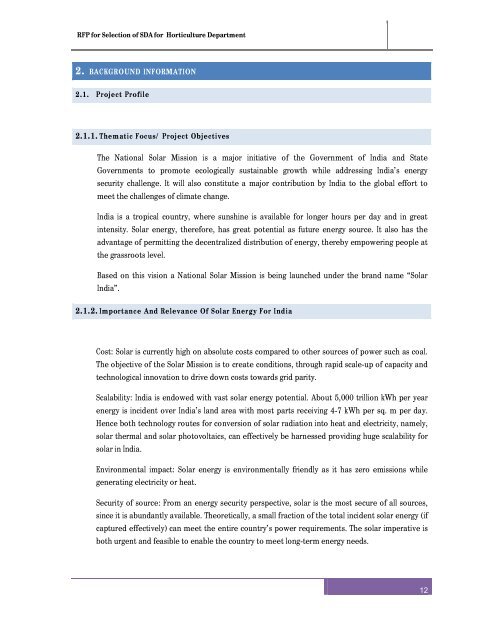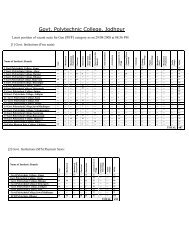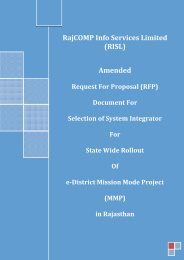RFP after pre bid meeting for selection of SDA - Directorate of ...
RFP after pre bid meeting for selection of SDA - Directorate of ...
RFP after pre bid meeting for selection of SDA - Directorate of ...
- No tags were found...
Create successful ePaper yourself
Turn your PDF publications into a flip-book with our unique Google optimized e-Paper software.
<strong>RFP</strong> <strong>for</strong> Selection <strong>of</strong> <strong>SDA</strong> <strong>for</strong> Horticulture Department2. BACKGROUND INFORMATION2.1. Project Pr<strong>of</strong>ile2.1.1. Thematic Focus/ Project ObjectivesThe National Solar Mission is a major initiative <strong>of</strong> the Government <strong>of</strong> India and StateGovernments to promote ecologically sustainable growth while addressing India’s energysecurity challenge. It will also constitute a major contribution by India to the global ef<strong>for</strong>t tomeet the challenges <strong>of</strong> climate change.India is a tropical country, where sunshine is available <strong>for</strong> longer hours per day and in greatintensity. Solar energy, there<strong>for</strong>e, has great potential as future energy source. It also has theadvantage <strong>of</strong> permitting the decentralized distribution <strong>of</strong> energy, thereby empowering people atthe grassroots level.Based on this vision a National Solar Mission is being launched under the brand name “SolarIndia”.2.1.2. Importance And Relevance Of Solar Energy For IndiaCost: Solar is currently high on absolute costs compared to other sources <strong>of</strong> power such as coal.The objective <strong>of</strong> the Solar Mission is to create conditions, through rapid scale-up <strong>of</strong> capacity andtechnological innovation to drive down costs towards grid parity.Scalability: India is endowed with vast solar energy potential. About 5,000 trillion kWh per yearenergy is incident over India’s land area with most parts receiving 4-7 kWh per sq. m per day.Hence both technology routes <strong>for</strong> conversion <strong>of</strong> solar radiation into heat and electricity, namely,solar thermal and solar photovoltaics, can effectively be harnessed providing huge scalability <strong>for</strong>solar in India.Environmental impact: Solar energy is environmentally friendly as it has zero emissions whilegenerating electricity or heat.Security <strong>of</strong> source: From an energy security perspective, solar is the most secure <strong>of</strong> all sources,since it is abundantly available. Theoretically, a small fraction <strong>of</strong> the total incident solar energy (ifcaptured effectively) can meet the entire country’s power requirements. The solar imperative isboth urgent and feasible to enable the country to meet long-term energy needs.12
















